Electrochemical Study and Mechanical Properties of Ti-Zr Alloy for Biomedical Applications
Abstract
1. Introduction
2. Materials and Methods
2.1. Ti-20Zr Alloy Preparation
2.2. Microscopic Observations
2.3. Microhardness and Indentation Depth
2.4. Electrochemical Behavior
3. Results and Discussions
3.1. Microstructure
3.2. Microhardness and Indentation Depth
3.3. Electrochemical Characterization
3.3.1. DC Electrochemical Test
3.3.2. AC Electrochemical Test
- -
- Rs: Solution resistance. The resistance due to the electrolyte solution through which the current passes.
- -
- Qp: CPE corresponding to the porous external passive layer, characterized by Yp0 and np.
- -
- Rp: Resistance attributed to the external porous layer.
- -
- Qc: CPE corresponding to the inner passive layer. characterized by Yc 0 and nc.
- -
- Rc: Polarization resistance of the alloy.
3.4. Scanning Electron Microscopy Observations after Corrosion Tests
4. Conclusions
- -
- The heat-treated Ti-20Zr alloy exhibited a fully lamellar α and β microstructure with α-rich grain boundaries. A fine needle-like microstructure was observed in the vicinity of the grain boundaries. The needle microstructure is a typical α’martensitic phase of Ti which is attributed to the substitutional Zr added to the alloy’s composition, as well as to the heat treatment followed by fast cooling in air.
- -
- In our study, a reversed ISE dominated the hardness measurements when loads up to 20 gf were employed; moreover, using a low range of loads, the α and β phases could be studied in more detail, and it was found out that the α phase is softer by about 30% in comparison to the β phase.
- -
- The Ti-20Zr alloy showed better mechanical properties in terms of hardness and estimated tensile strength than cp-Ti and pure Zr. The estimated tensile strength calculated based on the measured hardness values was around 825 MPa, indicating an increased value in comparison to the non-treated Ti-20Zr.
- -
- The heat treatment applied to Ti-20Zr increased the corrosion resistance across the potential range compared to Ti Cp.
- -
- Surface analysis by SEM and EDS methods showed that the surface topography is characterized by a porous external film, suitable for the osteoinductive growth of bone. The high concentration of oxygen, compared to the bulk material prior to testing, indicates the formation of a protective oxide layer which enhances the electrochemical properties of the alloy in simulated body fluid.
Author Contributions
Funding
Data Availability Statement
Conflicts of Interest
References
- Elani, H.W.; Starr, J.R.; Da Silva, J.D.; Gallucci, G.O. Trends in Dental Implant Use in the U.S., 1999–2016, and Projections to 2026. J. Dent. Res. 2018, 97, 1424–1430. [Google Scholar] [CrossRef] [PubMed]
- Popa, M.V.; Vasilescu, E.; Drob, P.; Anghel, M.; Vasilescu, C.; Mirza-Rosca, I.; Lopez, A.S. Anodic passivity of some titanium base alloys in aggressive environments. Mater. Corros. 2002, 53, 51–55. [Google Scholar] [CrossRef]
- Kandaswamy, E.; Harsha, M.; Joshi, V.M. Titanium corrosion products from dental implants and their effect on cells and cytokine release: A review. J. Trace Elem. Med. Biol. 2024, 84, 127464. [Google Scholar] [CrossRef] [PubMed]
- Liu, X.; Chen, S.; Tsoi, J.K.; Matinlinna, J.P. Binary titanium alloys as dental implant materials—A review. Regen. Biomater. 2017, 4, 315–323. [Google Scholar] [CrossRef] [PubMed]
- Naji, F.A.A.; Murtaza, Q.; Niranjan, M. Challenges and opportunities in nano finishing of titanium alloys for biomedical applications: A review. Precis. Eng. 2024, 88, 81–99. [Google Scholar] [CrossRef]
- Vasilescu, E.; Drob, P.; Popa, M.; Anghel, M.; Lopez, A.S.; Mirza-Rosca, I. Characterisation of anodic oxide films formed on titanium and two ternary titanium alloys in hydrochloric acid solutions. Werkst. Und Korros. 2000, 51, 413–417. [Google Scholar] [CrossRef]
- Wachi, T.; Shuto, T.; Shinohara, Y.; Matono, Y.; Makihira, S. Release of titanium ions from an implant surface and their effect on cytokine production related to alveolar bone resorption. Toxicology 2015, 327, 1–9. [Google Scholar] [CrossRef]
- Brunette, D.M.; Tengvall, P.; Textor, M.; Thomsen, P. Titanium in Medicine; Springer: Berlin, Germany, 2001; ISBN 1868-1212. [Google Scholar]
- Exley, C.; Clarkson, E. Aluminium in human brain tissue from donors without neurodegenerative disease: A comparison with Alzheimer’s disease, multiple sclerosis and autism. Sci. Rep. 2020, 10, 7770. [Google Scholar] [CrossRef]
- Mirza, A.; King, A.; Troakes, C.; Exley, C. Aluminium in brain tissue in familial Alzheimer’s disease. J. Trace Elements Med. Biol. 2017, 40, 30–36. [Google Scholar] [CrossRef]
- Altuna, P.; Lucas-Taulé, E.; Gargallo-Albiol, J.; Figueras-Álvarez, O.; Hernández-Alfaro, F.; Nart, J. Clinical evidence on titanium–zirconium dental implants: A systematic review and meta-analysis. Int. J. Oral Maxillofac. Surg. 2016, 45, 842–850. [Google Scholar] [CrossRef]
- Bao, X.; Li, X.; Ding, J.; Liu, X.; Meng, M.; Zhang, T. Exploring the limits of mechanical properties of Ti-Zr binary alloys. Mater. Lett. 2022, 318, 132091. [Google Scholar] [CrossRef]
- Takahashi, M.; Kikuchi, M.; Okuno, O. Grindability of Dental Cast Ti-Zr Alloys. Mater. Trans. 2009, 50, 859–863. [Google Scholar] [CrossRef]
- Dima, C.; Agop-Forna, D.; Moldoveanu, S.B.; Forna, C.N. Influence of Ti-6Al-4V and Ti-15Zr Dental Implants on the Stress in Mandibular Bone A finite element analysis study. Mater. Plast. 2019, 56, 469–473. [Google Scholar] [CrossRef]
- Grandin, H.M.; Berner, S.; Dard, M. A Review of Titanium Zirconium (TiZr) Alloys for Use in Endosseous Dental Implants. Materials 2012, 5, 1348–1360. [Google Scholar] [CrossRef]
- Izquierdo, J.; Mareci, D.; Bolat, G.; Santana, J.J.; Rodríguez-Raposo, R.; Fernández-Mérida, L.C.; Burtan, L.; Trincă, L.C.; Souto, R.M. Improvement of the Corrosion Resistance of Biomedical Zr-Ti Alloys Using a Thermal Oxidation Treatment. Metals 2020, 10, 166. [Google Scholar] [CrossRef]
- Fukuo, M.; Kariya, S.; Umeda, J.; Kondoh, K.; Yoshiya, M. Strengthening Mechanisms of Powder Metallurgy Extruded CP Titanium Materials with Zirconium and Oxygen Solid Solution via Decomposition of ZrO2 Additives in Sintering. J. Jpn. Soc. Powder Powder Met. 2018, 65, 746–755. [Google Scholar] [CrossRef]
- Moreno, J.M.C.; Vasilescu, E.; Drob, P.; Osiceanu, P.; Vasilescu, C.; Drob, S.I.; Popa, M. Surface analysis and electrochemical behavior of Ti–20Zr alloy in simulated physiological fluids. Mater. Sci. Eng. B Solid-State Mater. Adv. Technol. 2013, 178, 1195–1204. [Google Scholar] [CrossRef]
- Zhou, H.; Hou, R.; Yang, J.; Sheng, Y.; Li, Z.; Chen, L.; Li, W.; Wang, X. Influence of Zirconium (Zr) on the microstructure, mechanical properties and corrosion behavior of biodegradable zinc-magnesium alloys. J. Alloys Compd. 2020, 840, 155792. [Google Scholar] [CrossRef]
- Correa, D.; Vicente, F.; Donato, T.; Arana-Chavez, V.; Buzalaf, M.; Grandini, C. The effect of the solute on the structure, selected mechanical properties, and biocompatibility of Ti–Zr system alloys for dental applications. Mater. Sci. Eng. C 2014, 34, 354–359. [Google Scholar] [CrossRef]
- Wang, B.; Ruan, W.; Liu, J.; Zhang, T.; Yang, H.; Ruan, J. Microstructure, mechanical properties, and preliminary biocompatibility evaluation of binary Ti–Zr alloys for dental application. J. Biomater. Appl. 2019, 33, 766–775. [Google Scholar] [CrossRef]
- Ou, P.; Hao, C.; Liu, J.; He, R.; Wang, B.; Ruan, J. Cytocompatibility of Ti-xZr alloys as dental implant materials. J. Mater. Sci. Mater. Med. 2021, 32, 50. [Google Scholar] [CrossRef] [PubMed]
- Florido-Suarez, N.; Hulka, I.; Mirza-Rosca, J.; Saceleanu, A. Stability Range of Ti-Zr Alloy for Dental Implants. Microsc. Microanal. 2022, 28, 1034–1039. [Google Scholar] [CrossRef]
- Issariyapat, A.; Huang, J.; Teramae, T.; Kariya, S.; Bahador, A.; Visuttipitukul, P.; Umeda, J.; Alhazaa, A.; Kondo, K. Microstructure refinement and strengthening mechanisms of additively manufactured Ti-Zr alloys prepared from pre-mixed feedstock. Addit. Manuf. 2023, 73, 103649. [Google Scholar] [CrossRef]
- ASM Handbook: Metallography and Microstructures; Voort, G.F.V., Ed.; ASM International: Novelty, OH, USA, 1992; Volume 9. [Google Scholar]
- Salsi, E.; Chiumenti, M.; Cervera, M. Modeling of Microstructure Evolution of Ti6Al4V for Additive Manufacturing. Metals 2018, 8, 633. [Google Scholar] [CrossRef]
- Moreno, J.M.C.; Popa, M.; Ivanescu, S.; Vasilescu, C.; Drob, S.I.; Neacsu, E.I.; Popa, M.V. Microstructure, mechanical properties, and corrosion resistance of Ti-20Zr alloy in undoped and NaF doped artificial saliva. Met. Mater. Int. 2014, 20, 177–187. [Google Scholar] [CrossRef]
- Chávez, J.; Jimenez, O.; Diaz-Luna, J.; Bravo-Barcenas, D.; Alvarado-Hernández, F.; Flores, M.; Suárez-Martínez, R. Microstructure and corrosion characterization of a Ti-30Zr alloy with Ta additions processed by arc-melting for biomedical applications. Mater. Lett. 2021, 284, 129041. [Google Scholar] [CrossRef]
- Min, X.H.; Zhang, L.; Sekido, K.; Ohmura, T.; Emura, S.; Tsuchiya, K.; Tsuzaki, K. Strength evaluation of α and β phases by nanoindentation in Ti–15Mo alloys with Fe and Al addition. Mater. Sci. Technol. 2012, 28, 342–347. [Google Scholar] [CrossRef]
- Hulka, I.; Florido-Suarez, N.R.; Mirza-Rosca, J.C.; Saceleanu, A. Ti–Ta dental alloys and a way to improve gingival aesthethic in contact with the implant. Mater. Chem. Phys. 2022, 287, 126343. [Google Scholar] [CrossRef]
- Petrík, J.; Palfy, P. The Influence of the Load on the Hardness. Metrol. Meas. Syst. 2011, 18, 223–234. [Google Scholar] [CrossRef]
- Jiang, J.; Zhou, C.; Zhao, Y.; He, F.; Wang, X. Development and properties of dental Ti-Zr binary alloys. J. Mech. Behav. Biomed. Mater. 2020, 112, 104048. [Google Scholar] [CrossRef]
- Froes, F.H.; Qian, M. Titanium in Medical and Dental Applications; Elsevier: Amsterdam, The Netherlands, 2018; ISBN 9780128124567. [Google Scholar]
- Wang, X.; Zhan, W.; Gui, B. Effect of cerium nitrate and salicylic acid on the titanium-zirconium chemical conversion coating of 6061 aluminum alloy. Anti-Corros. Methods Mater. 2020, 67, 205–213. [Google Scholar] [CrossRef]
- Zhang, Y.; Davenport, A.J.; Burke, B.; Vyas, N.; Addison, O. Effect of Zr Addition on the Corrosion of Ti in Acidic and Reactive Oxygen Species (ROS)-Containing Environments. ACS Biomater. Sci. Eng. 2018, 4, 1103–1111. [Google Scholar] [CrossRef] [PubMed]
- Boukamp, B.A. A Nonlinear Least Squares Fit procedure for analysis of immittance data of electrochemical systems. Solid State Ionics 1986, 20, 31–44. [Google Scholar] [CrossRef]
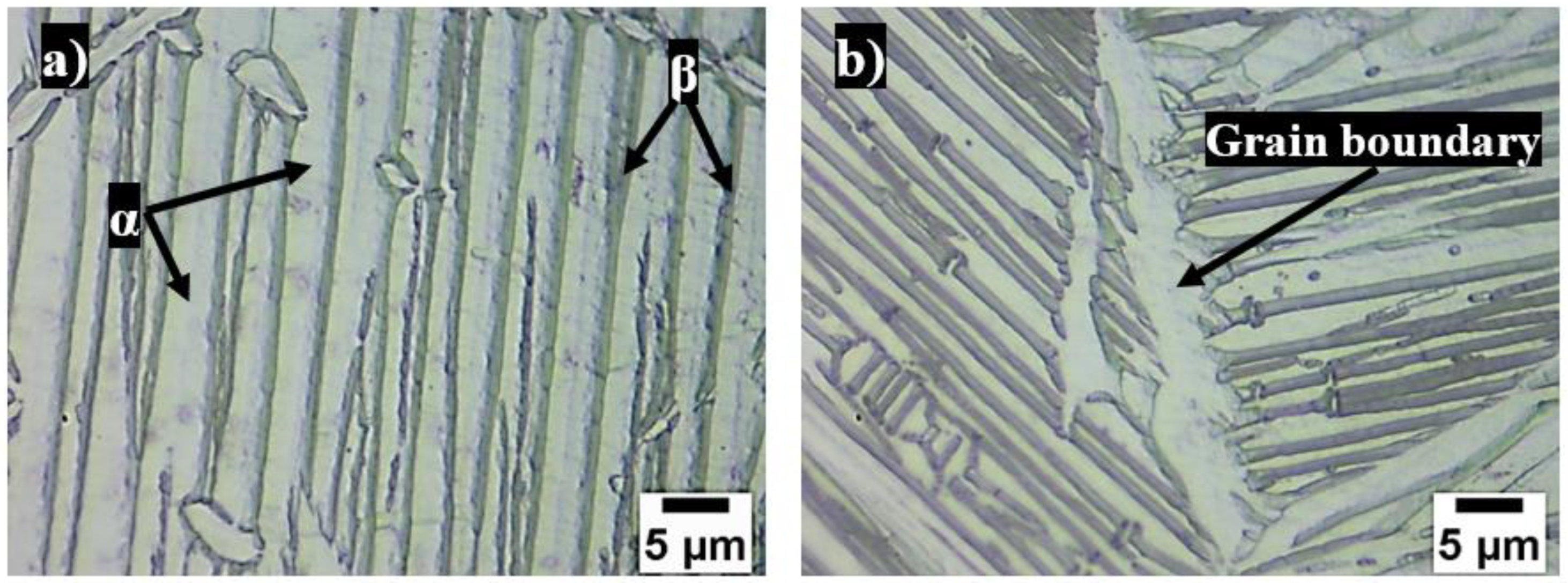
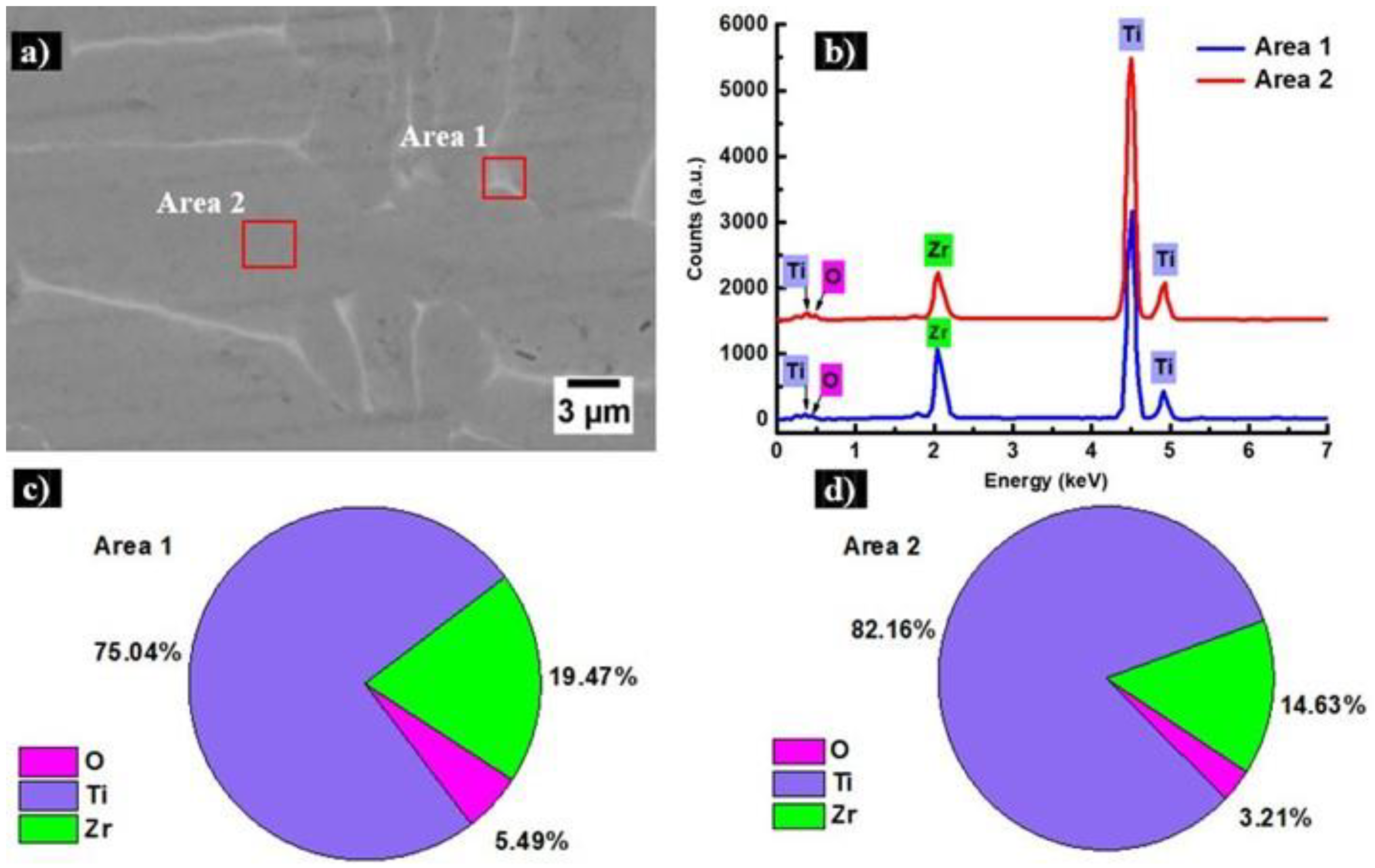
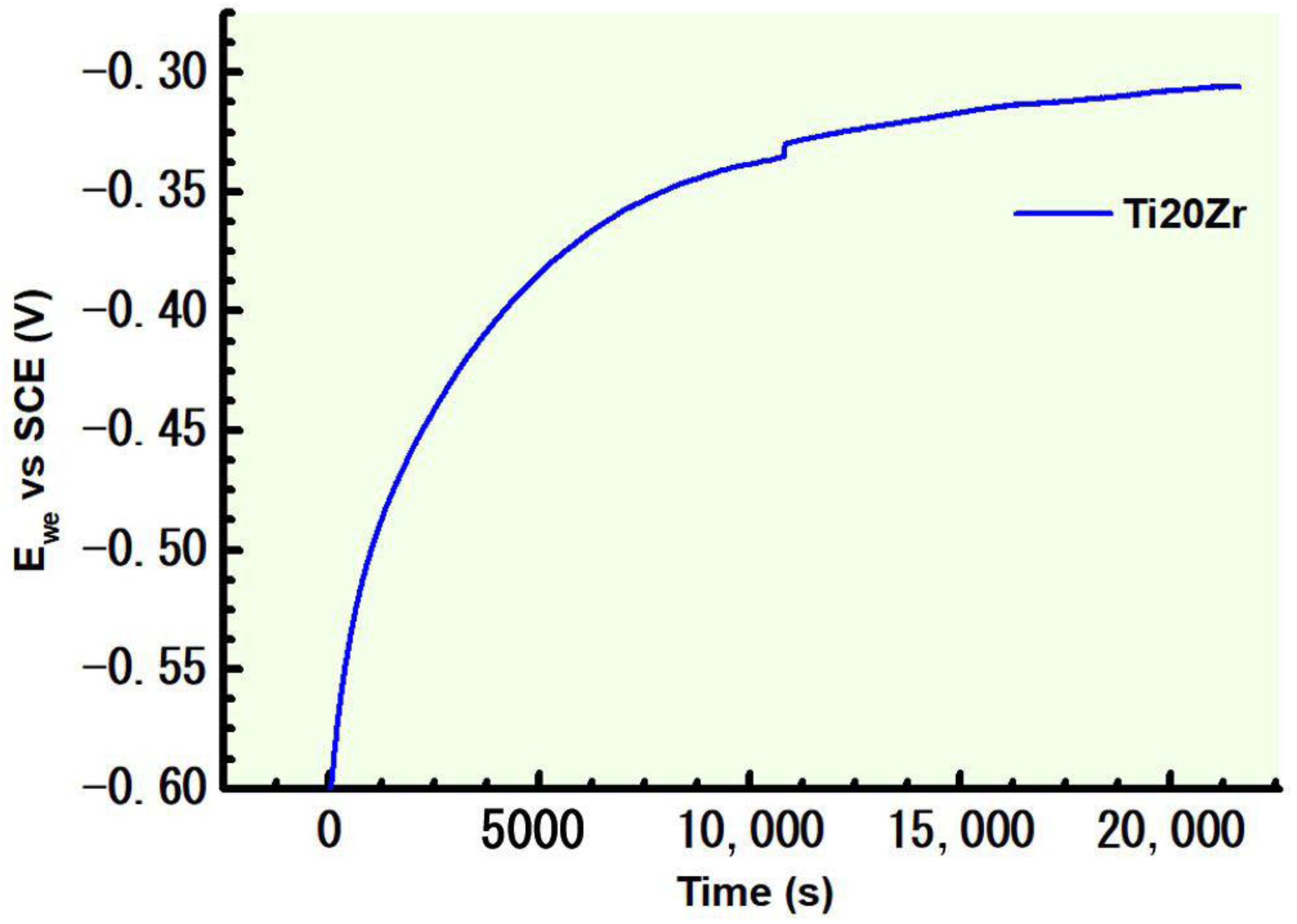
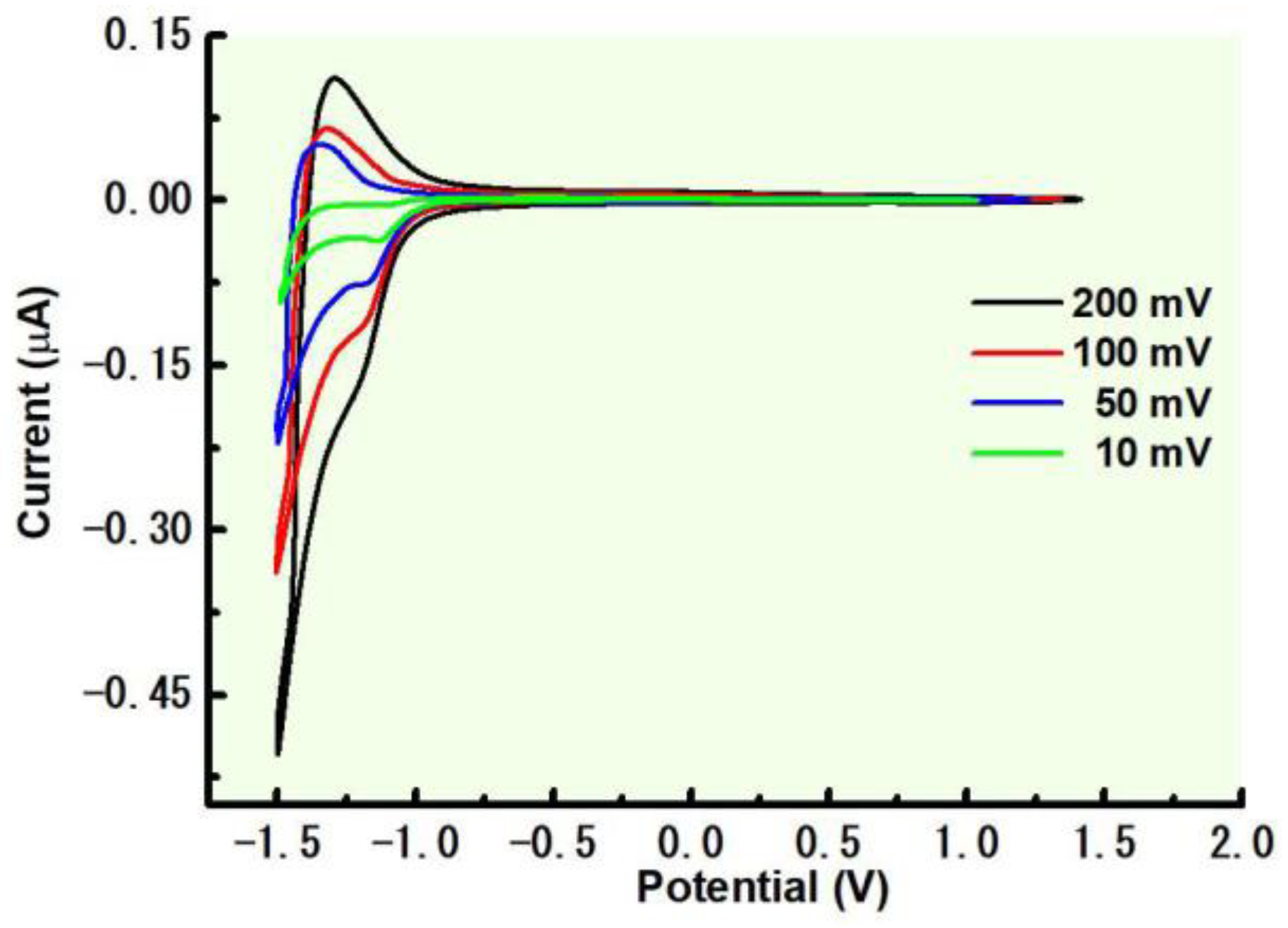
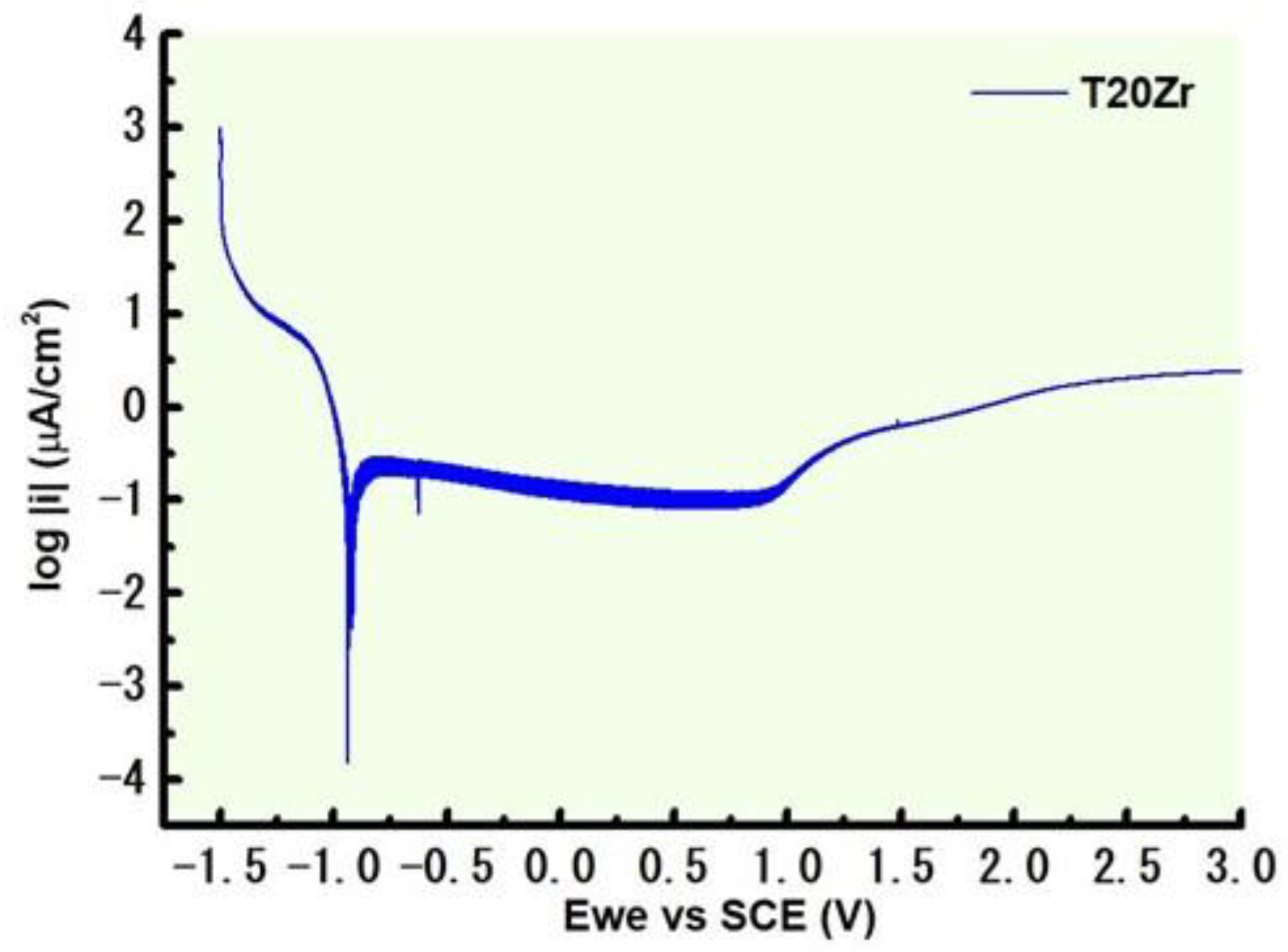
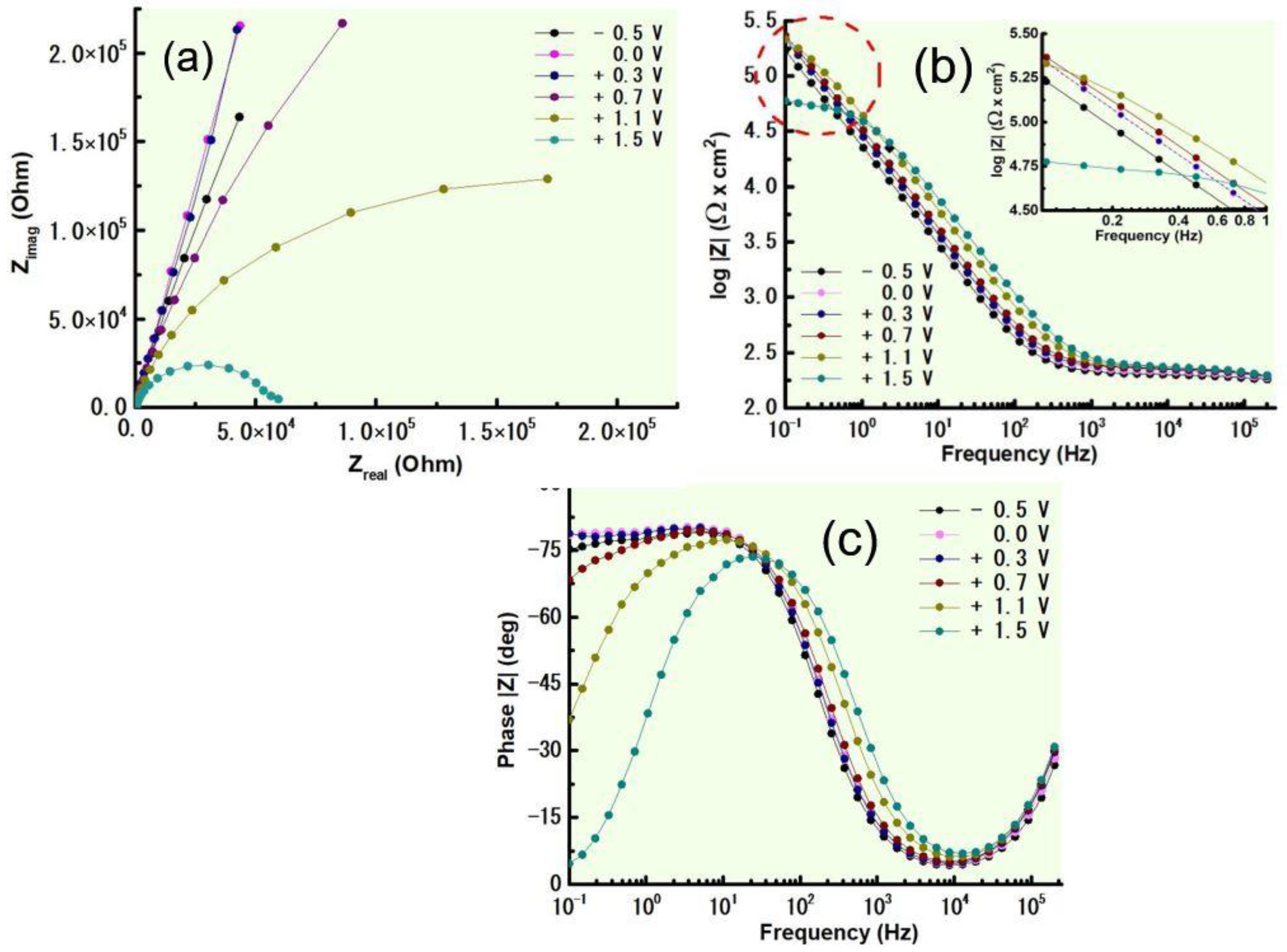
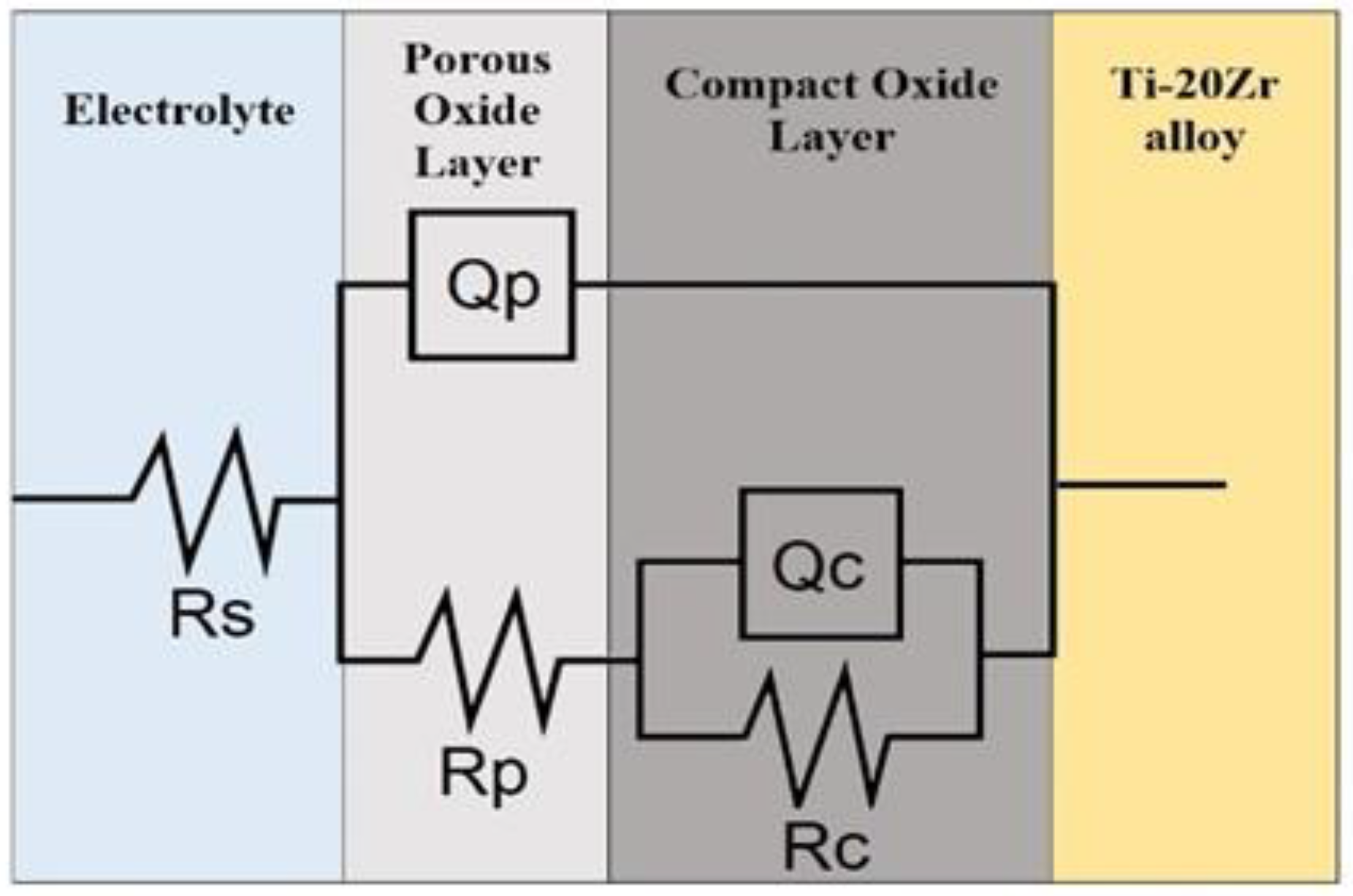
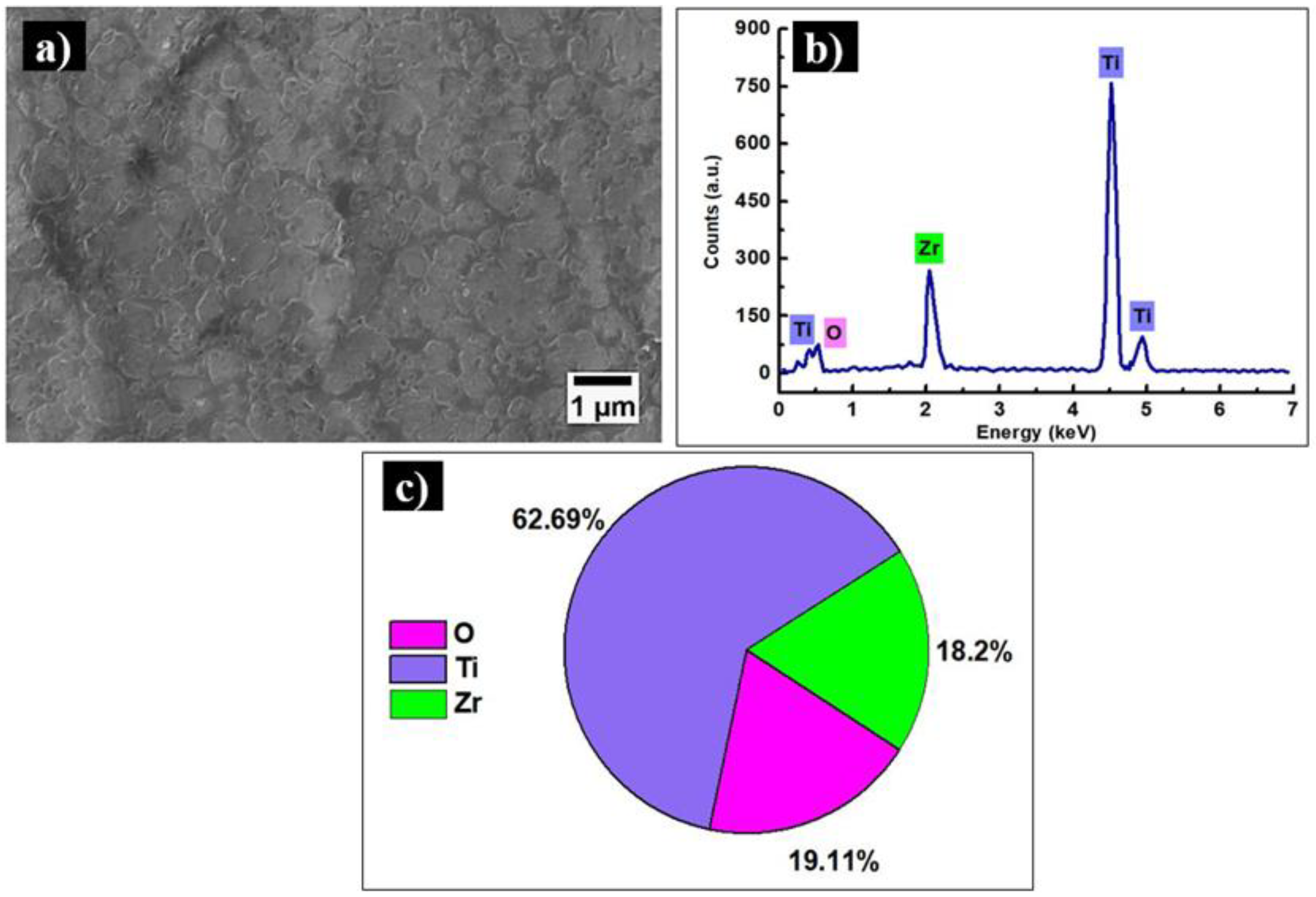
| Soft and Hard Phases in Ti-20Zr | |||
|---|---|---|---|
| Load (gf) | Phase | Hardness (HV) | Indentation Depth (µm) |
| 0.5 | Soft | 37.2 | 0.7 |
| Hard | 49.9 | 0.6 | |
| 5 | Soft | 163.8 | 1.1 |
| Hard | 288.5 | 0.8 | |
| 10 | Soft | 193.9 | 1.4 |
| Hard | 241.7 | 1.2 | |
| 20 | Soft | 202.6 | 1.9 |
| Hard | 299.1 | 1.6 | |
| 50 | Average | 234.1 | 2.8 |
| 100 | Average | 228.7 | 4.1 |
| 200 | Average | 239.6 | 5.6 |
| Potential | Yp0 [S·cm−2·sn] | np | Rp [Ω·cm2] | Yc0 [S·cm−2·sn] | np | Rc [Ω·cm2] | χ2 |
|---|---|---|---|---|---|---|---|
| −0.5 V | 4.1 × 10−9 | 0.95 | 200.1 | 8.3 × 10−6 | 0.89 | 1.3 × 106 | 9.7 × 10−4 |
| 0 V | 5.1 × 10−9 | 0.93 | 213.9 | 6.5 × 10−6 | 0.91 | 2.8 × 106 | 8.3 × 10−4 |
| 0.3 V | 5.9 × 10−9 | 0.92 | 224.5 | 6.5 × 10−6 | 0.91 | 2.7 × 106 | 9.0 × 10−4 |
| 0.7 V | 6.1× 10−9 | 0.92 | 228.3 | 5.7 × 10−6 | 0.89 | 9.1 × 106 | 9.3 × 10−4 |
| 1.1 V | 5.4× 10−9 | 0.93 | 232 | 4.1 × 10−6 | 0.89 | 2.9 × 106 | 6.6 × 10−4 |
| 1.5 V | 5.9× 10−9 | 0.92 | 233.6 | 3.0 × 10−6 | 0.89 | 5.7 × 106 | 5.1 × 10−4 |
Disclaimer/Publisher’s Note: The statements, opinions and data contained in all publications are solely those of the individual author(s) and contributor(s) and not of MDPI and/or the editor(s). MDPI and/or the editor(s) disclaim responsibility for any injury to people or property resulting from any ideas, methods, instructions or products referred to in the content. |
© 2024 by the authors. Licensee MDPI, Basel, Switzerland. This article is an open access article distributed under the terms and conditions of the Creative Commons Attribution (CC BY) license (https://creativecommons.org/licenses/by/4.0/).
Share and Cite
Hulka, I.; Uțu, I.-D.; Brito-Garcia, S.; Verdu-Vazquez, A.; Mirza-Rosca, J.C. Electrochemical Study and Mechanical Properties of Ti-Zr Alloy for Biomedical Applications. Crystals 2024, 14, 493. https://doi.org/10.3390/cryst14060493
Hulka I, Uțu I-D, Brito-Garcia S, Verdu-Vazquez A, Mirza-Rosca JC. Electrochemical Study and Mechanical Properties of Ti-Zr Alloy for Biomedical Applications. Crystals. 2024; 14(6):493. https://doi.org/10.3390/cryst14060493
Chicago/Turabian StyleHulka, Iosif, Ion-Dragoș Uțu, Santiago Brito-Garcia, Amparo Verdu-Vazquez, and Julia C. Mirza-Rosca. 2024. "Electrochemical Study and Mechanical Properties of Ti-Zr Alloy for Biomedical Applications" Crystals 14, no. 6: 493. https://doi.org/10.3390/cryst14060493
APA StyleHulka, I., Uțu, I.-D., Brito-Garcia, S., Verdu-Vazquez, A., & Mirza-Rosca, J. C. (2024). Electrochemical Study and Mechanical Properties of Ti-Zr Alloy for Biomedical Applications. Crystals, 14(6), 493. https://doi.org/10.3390/cryst14060493










